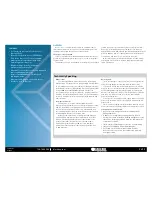
724-746-5500
blackbox.com
BLACK BOX
®
2 of 3
06/29/2010
#26542
»
Tests network cable pairs for Power over
Ethernet (PoE).
»
Identifies the power type as IEEE 802.3af,
Cisco Inline Power (ILP), or nonstandard.
»
Makes power measurements with loads
simulating powered devices.
»
Displays voltage, polarity, and power
configuration for wire pairs.
»
Measures loop resistance to identify damaged
cables and bad punchdowns.
»
Detects 10/100/1000BASE-TX link speed
and duplex mode.
»
Measures cable length, opens, and shorts.
»
Provides a port ID function.
FEaTurEs
Use
NetPower
to conduct power tests with simulated loads to
ensure that VoIP phones, access points, security cameras, and other
equipment will operate properly on your PoE network.
The power is in your hands.
If you’re responsible for installing and maintaining networks that
use Power over Ethernet (PoE), make the
NetPower
an essential part
of your toolbox.
This advanced, easy-to-use handheld tester can give you the peace
OVERVIEW
What is PoE?
The seemingly universal network connection, twisted-pair
Ethernet cable, has another role to play: providing electrical power
to low-wattage electrical devices. Power over Ethernet (PoE) was
ratified by the Institute of Electrical and Electronic Engineers (IEEE)
in June 2000 as the 802.3af-2003 standard. It defines the
specifications for low-level power delivery—roughly 13 watts at
48 VDC—over twisted-pair Ethernet cable to PoE-enabled devices
such as IP telephones, wireless access points, Web cameras, and
audio speakers.
How does PoE work?
The way it works is simple. Ethernet cable that meets
CAT5 (or better) standards consists of four twisted pairs of cable,
and PoE sends power over these pairs to PoE-enabled devices.
In one method, two wire pairs are used to transmit data, and
the remaining two pairs are used for power. In the other method,
power and data are sent over the same pair.
When the same pair is used for both power and data, the
power and data transmissions don’t interfere with each other.
Because electricity and data function at opposite ends of the
frequency spectrum, they can travel over the same cable.
Electricity has a low frequency of 60 Hz or less, and data
transmissions have frequencies that can range from 10 million
to 100 million Hz.
Basic structure.
There are two types of devices involved in PoE configurations:
Power Sourcing Equipment (PSE) and Powered Devices (PD).
PSEs, which include end-span and mid-span devices, provide
power to PDs over the Ethernet cable. An end-span device is often
a PoE-enabled network switch that’s designed to supply power
directly to the cable from each port. A mid-span device is inserted
between a non-PoE device and the network, and it supplies
power from that juncture.
Power injectors, a third type of PSE, supply power to a specific
point on the network while the other network segments remain
without power.
PDs are pieces of equipment like surveillance cameras, sensors,
wireless access points, and any other devices that operate on PoE.
PoE applications and benefits.
• Use one set of twisted-pair wires for both data and low-
wattage appliances.
• In addition to the applications noted previously, PoE also
works well for video surveillance, building management, retail
video kiosks, smart signs, vending machines, and retail point-
of-information systems.
• Save money by eliminating the need to run electrical wiring.
• Easily move an appliance with minimal disruption.
• If your LAN is protected from power failure by a UPS,
the PoE devices connected to your LAN are also protected
from power failure.
Technically speaking
of mind you need to check and verify Power over Ethernet links—
before you accidentally damage any equipment! You can even
differentiate between IEEE standard power and manufacturer-specific
power. In addition, power for devices can run over different pairs
or on all pairs, and the
NetPower
will tell you in no time.
Other test functions include tone generation for cable tracing.
You can also use the tester to measure cable length and identify
switch or hub ports.












